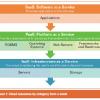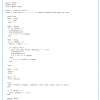 |
Agile Teamwork: Three Ways to Minimize Handoffs Rather than rely on large handoffs between specialties, high-performing Scrum teams learn to do a little bit of everything all the time during a sprint. To do this effectively, teams must make three changes: shift from writing about requirements to talking about them, reduce the size of handoffs and make them more frequently, and pay more attention to the size of the product backlog items that they bring into their sprints.
|
|
 |
Regulation, Compliance, and Delivery Regulatory compliance may seem daunting, and penalties for non-compliance can be severe. What is the QA professional’s role in making it work?
|
|
 |
Building Highly Productive Teams Using a Commitment-to-Progress Ratio: Work Committed vs. Done This article explains methods to build a team that will embrace "required work" and deliver robust software in a predictable fashion. It proposes a measure that helps calculate the throughput of an agile team by comparing work committed to work actually done.
|
|
|
|
FAQ: Do I Need to Program to be a Tester on an Agile Team? In this installment of FAQ, SQE Trainer Janet Gregory answers one of the questions students ask her most often.
|
|
|
|
Does Agile Change the Way a Tester Works? In this installment of FAQ, SQE Trainer Jeffery Payne answers one of the questions students ask him most often.
|
|
 |
Agile Code for Agile Teams What makes a team agile? Is it in the way it plans projects or how it engineers its products? In this article, Steve Berczuk explains how agile code and technical practices can help a team stay agile across the product lifecycle.
|
|
|
|
Creative Agility Many new products being developed require the contribution of artists and other such "creatives," but artists often view the creative process as an organic thing that cannot be analyzed, dissected, or reduced to a set of defined practices without killing it. This article explores barriers such as these to the introduction of agile methods and how these barriers can be overcome.
|
|
|
|
Learning For Agile Testers, Part 2 In part one of our Learning for Agile Testers series, we addressed general "thinking" skills that go beyond technical competence and how learning these enhances the value you contribute. In part two, we discuss some specific technical skills that benefit testers and how to acquire them.
|
|
|
|
The Three Amigos: All for One and One for All Analysts determine what needs to be created. Programmers create it. Testers find the holes in the work of both. That's one way to do it, but all three can collaborate to do these things better, and more easily, too.
|
|
 |
When Software Smells Bad Most software needs to be "maintainable" and have high "internal quality." But what does that mean in practical terms? Code smells form a vocabulary for discussing code quality and how well suited code might be to change. The smells also provide good indications as to what to refactor and how.
|
|

